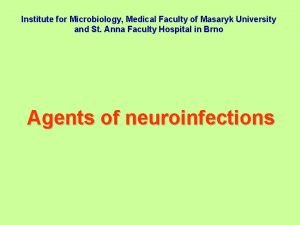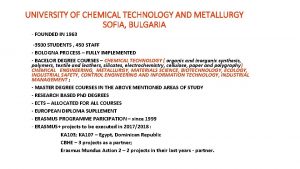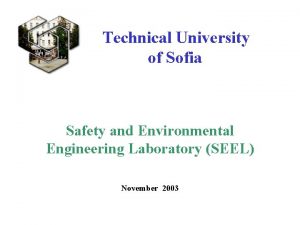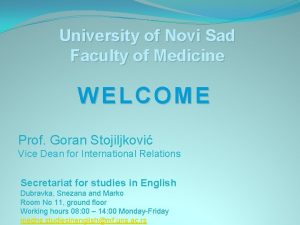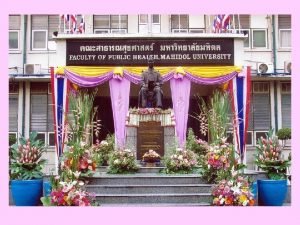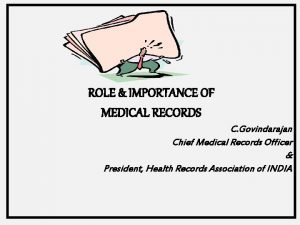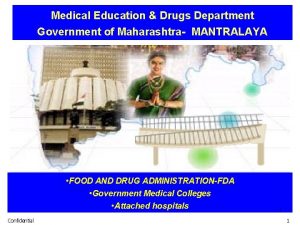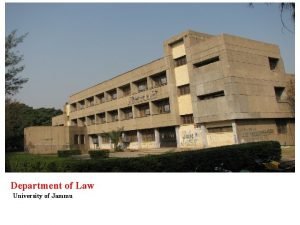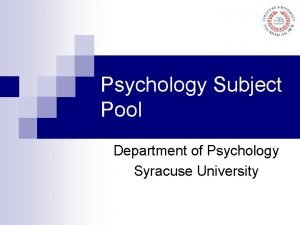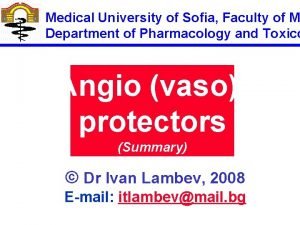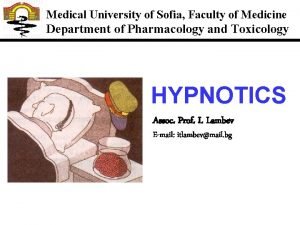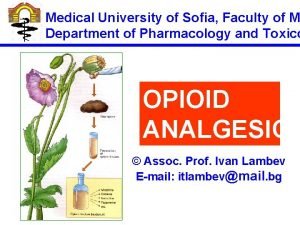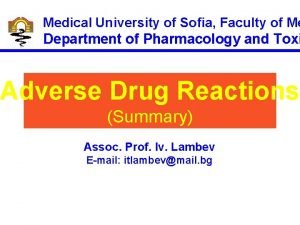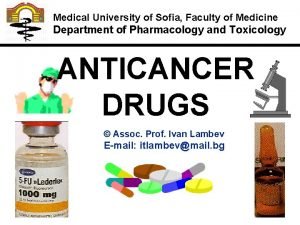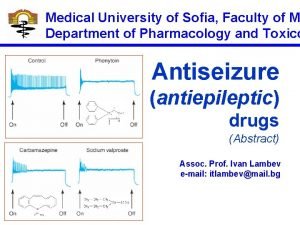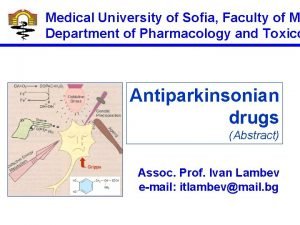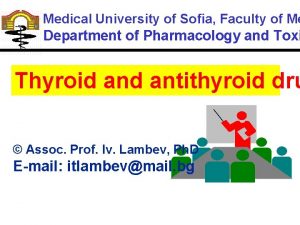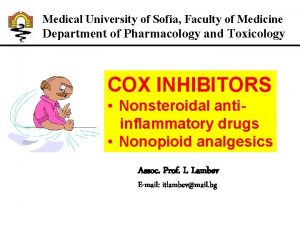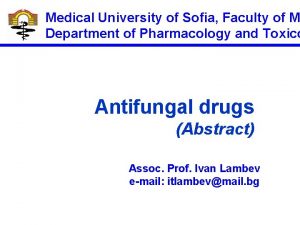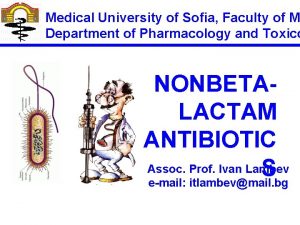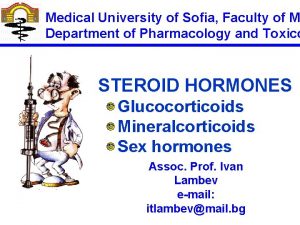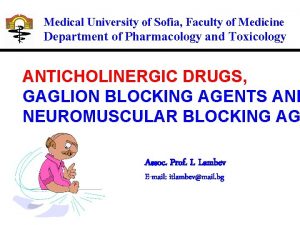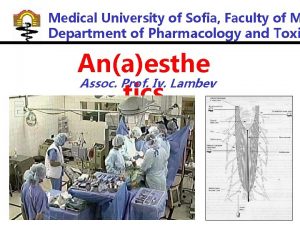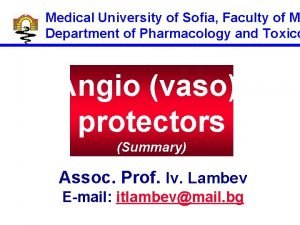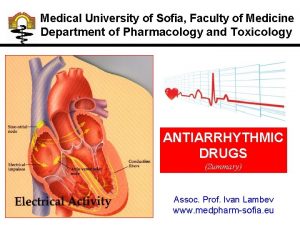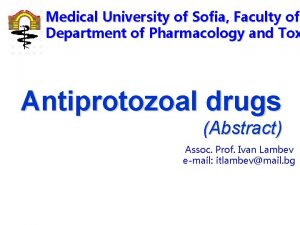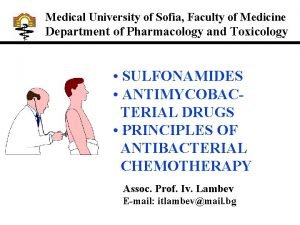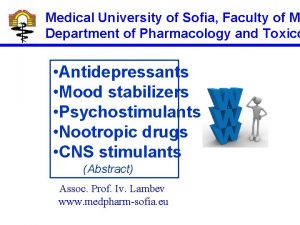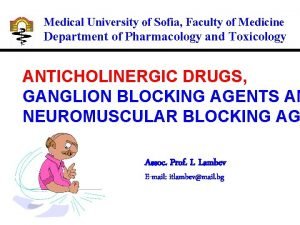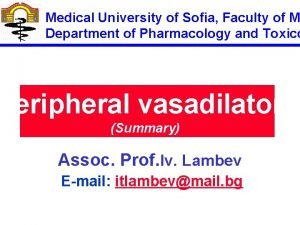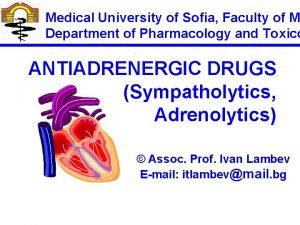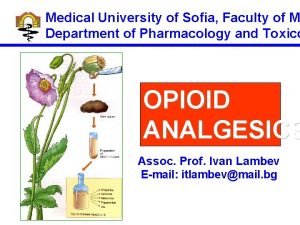Medical University of Sofia Faculty of M Department

























































- Slides: 57

Medical University of Sofia, Faculty of M Department of Pharmacology and Toxico • Antidepressants • Mood stabilizers • Psychostimulants • Nootropic drugs • CNS stimulants (Abstract) ssoc. Prof. Ivan Lambev (e-mail: itlambev@mail. b

Depression is a heterogeneous disorder. A sim classification based on presumed origin is as f (1) brief reactive or secondary depression (most comm occurring in response to real stimuli such as grief, illne (2) major depression (melancholic and recurrent depr a genetically determined biochemical disorder manifes inability to experience ordinary pleasure or to cope wit life events; (3) manic-depressive depression (depression associate bipolar affective disorder) Pharmacologic treatment of depressions is very important a continuing role for electroconvulsive therapy for severe life-threatening depression is also noted.

Depression is one of the most common psychiatric disord At any given moment, about 3– 5% of the population is de and an estimated 10% of people may become depressed their lives. The symptoms of depression are often sub unrecognized both by patients and by physicians. Pa vague complaints that resist explanation as manifestation somatic disorders and those who might be simplistically d as "neurotic" should be suspected of being depressed. So the introduction of reserpine in the early 1950 s, it became apparent that the drug could induce depression by inhibiti neuronal storage of amine neurotransmitters such as 5 -H Reserpine induced depression and depleted stores of am transmitters. It was reasoned, depression must be associ with decreased functional amine-dependent synaptic tran

NA (noradrenaline) = NE (norepinephrine

Rauwolfia serpentina Bent (a small indian shrub) • Reserpine • Ajmaline

Pathogenesis of depression. Mechanism of action of antidepressants The idea that depression must be associated with decreased functional amine-dependent synaptic transmission provided the basis for what became known as the amine hypothesis of depression. By extension, drugs that increased amine function in appropriate synaptic areas would relieve depression. The amine hypothesis has provided the major

(5 -HT) (NE) (DA) The effects of DA, 5 -HT and NE on the brain funct

Raised neurotransmitter concentrations produce immediate alterations in postsynaptic receptor activation, leading to changes in second messenger (intracellular) systems and to gradual modifications in cellular protein expression. Antidepressants increase a cyclic AMP response-element binding (CREB) protein which in turn is involved in regulating the transcription of genes that influence survival of other proteins including brain derived neurotrophic factor (BDNF) which exerts effects on neuronal growth. The role of BDNF in depression is supported by the observation that stress both reduces its expression and impairs neurogenesis.


The monoamine hypothesis of depression is an oversimplification of a complicated picture. Other systems that are implicated in the etiology of depression (and which provide potential targets for drug therapy) include the hypothalamopituitarythyroid axis and the hypothalamopituitary-adrenal axis (HPA). The finding that 50% of depressed patients have elevated plasma cortisol concentrations constitutes evidence that depression may be associated with increased HPA drive.

Sites of action of antidepressants NE – norepinephrine NERIs – norepinephrine reuptake inhibitors 5 -HT – serotonin SSRIs – selective serotonin reuptake inhibitors TCAs – tricyclic antideperssant MAO – monoaminooxidase

volution of antidepressants and classification by mechanism of a

Structural relationships between various tricyclic antidepressants (TCAs) Their structures are similar to phenothia

Selective serotonin reuptake inhibitors (SSRIs).

Pharmacokinetics The antidepressants are generally well absorbed after oral administration. Steady-state plasma concentrations of TCAs show great individual variation but correlate with therapeutic effect. Antidepressants in general are inactivated principally by metabolism by hepatic cytochrome P 450 enzymes (CYP 2 D 6 and CYP 3 A 4 etc. ). Other P 450 enzymes are CYP 1 A 2 inhibited by the SSRI fluvoxamine, and induced by cigarette smoking, substrates include caffeine and the atypical psychotics (clozapine and olanzapine).

Several of these drugs produce active metabolites which prolong their action (e. g. fluoxetine is metabolized to norfluoxetine, t 1/2 200 h). The metabolic products of certain TCAs are antidepressants in their own right, e. g. nortriptyline (from amitriptyline), desipramine (from imipramine). Half-lives of TCAs and SSRIs are long (> 15 h). Around 7% of the Caucasian population have very limited CYP 2 D 6 enzyme activity. Such “poor metabolizers” may find standard doses of tricyclic antidepressants intolerable and it is often worth starting at a very low dose.

Clinical indications for antidepressants The major indication is to treat depression, but a numbe other uses have been established by clinical experience Antidepressants may benefit most forms of anxiety disorder, generalized anxiety disorder, post-traumatic str obsessive-compulsive disorder and social phobia), migra SSRIs are effective in milder cases of the eating disorder bulimia nervosa, particularly fluoxetine (in higher doses are required for depression). This effect is independent o on depression (which may co-exist) and may therefore in action on transmitter systems other than those involved i modulating depression. Antidepressants appear to be ineffective in anorexia nerv

SSRIs (selective serotonin reuptake inhibitors) are used in: • chronic anxiety • depression • bulimia neurosa (fluoxetine – in higher doses)

Schematic representation of the time course of panic tr Adapted from Bennett and Brown (2003)

Mode of use The action of TCAs in ameliorating mood is usually absent in the first 2 weeks of therapy and at least 4 weeks must elapse to constitute an adequate trial. Where a minimal response is noted in this period, it is reasonable to extend the trial to 6 weeks to see if further benefit is achieved. Dose titration is often necessary. By contrast, patients may experience unwanted drug effects immediately on starting treatment (and they should be warned), but such symptoms often diminish with time. TCAs are given either in divided doses or, for the more sedative compounds, as a single evening dose.

SSRIs have advantages over tricyclics in simplicity of introduction and use. Dose titration is often unnecessary since the minimum therapeutic dose can usually be tolerated as a starting dose. Divided doses are not required and administration is by a single morning or evening dose. Evidence suggests that patients commencing treatment on SSRIs are more likely to reach an effective dose than those starting on TCAs. Venlafaxine is licensed for treatment-resistant depression by gradual titration from 75 to 375 mg/day. There is some need for dose titration when using MAOIs although recommended starting doses may be effective.

When changing between SSRIs and/or TCAs, doses should be reduced progressively over 2– 4 weeks. Where a new drug is to be introduced its dose should be gradually increased as that of the substituted drug is reduced. Changes to or from MAOIs must be handled with great caution due to the dangers of unwanted interactions between antidepressants: MAOIs cannot safely be introduced within 2 weeks of stopping paroxetine, sertraline or TCAs (3 weeks). When a patient achieves remission, the antidepressant should be continued for at least 9 months at the dose which returned mood to normal. When ceasing use of an antidepressant, the dose should be reduced over at least 6 weeks to avoid a discontinuation syndrome.

Side effects of TCAs Anticholinergic (atropine-like): dry mouth, blurred visio accommodation disturbances, increased ocular pressure stipation, urinary retention, sweating, adynamic ileus (ver CNS: dizziness, tiredness, confusion, tremor, insomnia, seizures, sudden falls, exacerbation of psychotic sympto CVS: hypotension, sinus tachycardia, arrhythmia, impair conduction. Blood: leucopenia, agranulocytosis, thrombocytopenia, h anemia. Other side-effects: hypo- or hyperthermia, impaired res libido changes, exanthema, tinnitus, GI complaints, liver disturbances, increased body weight, neurological sympt

TCAs – Interactions Potential results MAOIs hyperthermia, palpitations, excitation Adrenomimetics hypertension, hyperthermia, tachycardia Alcohol effect of alcohol may be increased Clonidine, Methyldopa decreased hypotensive effects T 3, T 4 enhanced potential for CV toxicity Physostigmine antagonism Anticholinergics additional anticholinergic activity Neuroleptics inhibition of metabolism of antidepressants overreaction of levodopa Levodopa

Precautions: close supervision, especially in early ph treatment (suicide risk of TCAs). The possibility of unm a latent psychosis should be considered. A switch into a or hypomanic condition may occur (“switch process”). Caution in CVD, history of urinary retention, narrow-ang glaucoma and in thyroid disease. Side-effects of SSRIs (mainly during the 1 st and 2 nd weeks of treatment): CNS ache, restleness; CVS: bradycaria; GIT: nausea, diarrho The serotonin syndrome is a rare but dangerous comp and features restlessness, tremor, convulsions, coma and death. Risk is increased by co-administration with M the antimigraine drug sumatriptan and St. John's Wort.

Side-effects of SNERIs (Reboxetine) Dermatological: skin reactions CVS: hypertension (at high doses). Side-effects of MAOIs General: headache, perspiration, anorexia, hypotension CNS: insomnia, agitation, restlessness, confusion, dizzin CVS: arrhythmia, tachycardia, palpitations. Other effects: leucopenia, agranulocytosis, icterus (sma Following foods and beverages should be avoided: T containing nutrition: maturated cheese (“cheese syndro broad beans, smoked or pickled fish, meat extracts conta brewer's yeast, fermented sausages (e. g. salami); red wine, sherry, beer and excessive amounts of alcohol

Side-effects of 5 -HT & NERIs Venlafaxine produces some unwanted effects that resemble those of SSRIs with a higher incidence of nausea. Sustained hypertension (due to blockade of noradrenaline reuptake) is a problem in a small percentage of patients at high dose and blood pressure should be monitored when > 200 mg/day is taken. Side-effects of presynaptic alpha-2 -blockers Mirtazapine also has benefits in rarely being associated with sexual dysfunction and in improving sleep independent of mood but like TCAs it may cause unwanted sedation and weight gain.

Trazodone has structural similarities with TCAs but probably acts by antagonism of central presynaptic alpha-2 -adrenoceptors. It is an option for depressed patients where heavy sedation is required. Trazodone also has the advantages of lacking antimuscarinic effects and being relatively safe in overdose. Males should be warned of the possibility of priapism (painful penile erections), attributable to the drug's blockade of periferal apha-1 -adrenoceptors. Mianserin has the advantages of lacking antimuscarinic effects too, but this antidepressant rarely used due to associations with aplastic anaemia.

St John's Wort Hypericum perforatum)

St John's Wort Many patients with mild to moderate depression are aware of the benefits of the herbal remedy St. John's Wort. The active ingredients in the hypericum extract have yet to be identified and their mode of action is unclear, although it has been postulated that several of the known mechanisms of existing antidepressants are incorporated (inhibition of monoamine reuptake and the monoamine oxidase enzyme, as well as a stimulation of GABA receptors). A large multicentre trial found only limited evidence of benefit for St. John's Wort over placebo in significant major depression.

Use of St. John's Wort is complicated by the lack of standardization of the ingredients. Those who wish to take St. John's Wort should be made aware that it may cause dry mouth, dizziness, sedation, GI disturbance and confusion. Importantly also, it induces hepatic P 450 enzymes (CYP 1 A 2 and CYP 3 A 4) with the result that the plasma concentration and therapeutic efficacy of warfarin, oral contraceptives, some anticonvulsants, antipsychotics and HIV protease/reverse transcriptase inhibitors are reduced. Concomitant use of tryptophan and St John's Wort may cause serotoninergic effects including nausea and agitation.

Electroconvulsive therapy (ECT) involves the passage of a small electric charge across the brain by e applied to the frontotemporal aspects of the scalp with t inducing a tonic-clonic seizure. ECT requires the patien receiving a general anaesthetic, carrying the small risks valent to those associated with general anaesthesia in surgical operations. It may cause memory deficits altho generally transient. ECT is usually reserved for psychia where pharmacotherapy have been unsuccessful for in the severely depressed patient who has stopped eating drinking. Modern-day ECT is a safe and effective alte to pharmacotherapy and remains a first-line option in cl circumstances where rapid, response is desired, when be life-saving.

Mood stabilizers In bipolar affective disorder patients suffer episodes of mania, hypomania and depression, classically with periods of normal mood in between. Manic episodes involve greatly elevated mood, often interspersed with periods of irritability or undue excitement, accompanied by biological symptoms (increased energy, restlessness, decreased need for sleep, increased sex drive), loss of social inhibitions, irresponsible behaviour and grandiosity. Psychotic features may be present, particularly disordered thinking manifested by grandiose delusions and “flight of ideas” with rapid speech.

Hypomania is a less dramatic and dangerous presentation but retains the features of elation or irritability and the biological symptoms, abnormalities in speech and in social conduct to overfamiliarity and mild recklessness. Depressive episodes include depressive symptoms described before and may include psychotic features. Lithium salts are ineffective for prophylaxis of bipolar affective disorder in around 35% of patients and cause several unwanted effects. The search for alternatives has produced drugs that are more familiar as anticonvulsants, notably carbamazepine and sodium valproate, and possibly lamotrigine.

The mode of action is not fully understood. The main effect of lithium is probably to inhibit hydrolysis of inositol phosphate, so reducing the recycling of free inositol for synthesis of phosphatidylinositides. These intracellular molecules are part of the transmembrane signaling system that is important in regulating intracellullar calcium ion concentration, which subsequently affects neurotransmitter release. Other putative mechanisms involve the cyclic AMP “second messenger” system and monoaminergic and cholinergic neurotransmitters.

Effect of lithium on the IP 3 and DAG second-messenger The schematic diagram shows the synaptic membrane of a neuro (PIP 2, phosphatidylinositol-4, 5 -bisphosphate; PLC, phospholipas G, coupling protein; EFFECTS, activation of protein kinase C, mo of intracellular Ca 2+, etc. ) Lithium, by inhibiting the recycling of ino substrates, may cause depletion of the second-messenger sourc and therefore reduce the release of IP 3 and DAG.

Knowledge of pharmacokinetics of lithium is important for successful use since therapeutic plasma concentration is close to the toxic concentration (low therapeutic index). Lithium is a small ion that, given orally, is rapidly absorbed throughout the gut. High peak plasma concentrations are avoided by using sustained-release formulations which deliver the peak plasma lithium concentrations in about 5 h. With chronic use the plasma t 1/2 of lithium is 15– 30 h. Lithium is usually given 12 -hourly to avoid unnecessary fluctuation (peak and trough concentrations) and maintain a plasma concentration just below the toxic level. A steady-state plasma concentration will be attained after about 5– 6 days (i. e. 5 x t 1/2).

Lithium carbonate is effective treatment in > 75% of episodes of acute mania or hypomania. Because its therapeutic action takes 2– 3 weeks to develop, lithium is generally used in combination with lorazepam or diazepam (or with a neuroleptics where there also psychotic features). For prophylaxis, lithium is indicated when there have been two episodes of mood disturbance in two years, although in some cases it is advisable to continue with prophylactic use after one severe episode. When an adequate dose of lithium is taken consistently, around 65% of patients achieve improved control of their illness.

Lithium is also used to augment the action of antidepressants in treatment-resistant depression. Monitoring. The difference between therapeutic and toxic doses is narrow and therapy must be guided by monitoring of the plasma concentration once a steady state is reached. Increments are made at weekly intervals until the concentration lies within the required range of 0. 4– 1 mmol/L (maintenance at the lower level is preferred for elderly patients). The plasma concentration should be checked every three months. Thyroid function and renal function (plasma creatinine and electrolytes) should be measured before initiation and every 3 months during therapy.

Side-effects of Lithium General reactions: in case of overdose: nausea, thirst. CNS: ataxia, dysarthia, choreotetoid disturbances, extrapyrimidal symptoms, confusion, tremor, epileptic seizures, spasms, stupor, sedation, lethargy. CVS: arrhythmia, hypertension, circulatory collaps. Other effects: weight increase, muscular hypotonia, anorexia, nausea, vomiting, rash, acneiform eruptions, incontinence, dehydration, dry mouth, polyuria, albuminurea, glycosuria, myxoedema, fatigue, leucocytosis, hyperthyroidism.

The manic phase in bipolar affective disorder often requires treatment with neuroleptics (chlorpromazine, haloperidol), though lithium or valproic acid supplemented with high-potency benzodiazepines (eg, lorazepam or clonazepam) may suffice in milder cases. Recent controlled trials support the efficacy of monotherapy with atypical antipsychotics in the acute phase (up to 4 weeks) of mania, and olanzapine has been approved for this indication.

Psychostimulants have predominant cortical action. Thei effects are more important then those on medullary vital (1) Methylxanthines Three methylxanthines are pharmacologicall important: caffeine, theophylline, and theobr All of them occur naturally in certain plants. Only caffeine is used as a CNS stimulants. It is w consumed in the form of beverages, including as infusions or decoctions, derived from these plants

Methylxanthines (purine alkaloids) Caffeine, Theophylline, Theobromine Coffea Theobroma Cola acuminata. Thea sinensis arabica (seeds)cacao (cocoa) (Guru nuts) (leaves) In an average In 200 ml bottle In an average cup of coffee: cup of cocoa: of cola drink: cup of tea: Caffeine 75 mg Caffeine 4 mg Caffeine 30 mg Caffeine 50 mg Theobromine 200 mg Theophylline 1 mg

Actions of methylxanthines They block adenosine-1 -receptors. Adenosine acts as a mediators in CNS, CVS and other organs. Adenosine co bronchial muscles, dilates cerebral blood vessels, depre cardiac pacemaker and inhibits gastric secretions. Methylxanthines inhibite phosphodiestarease which deg intracelullarly c. AMP. Theophylline-containing preparatio enhance c. AMP accumulation. It results in bronchodilatio vasodilation and cardiac stimulation. Caffeine and theophylline are CNS stimulants, primarily higher centres. Caffeine (150 to 250 mg) produces a se wellbeing, alertness, beats boredom, allays fatigue; thin

becomes clear, improves performance and increases m activity. As a CNS stimulant caffeine is more active than phylline. In higher doses caffeine causes nervousness, lesness, panic, insomnia and excitement. Still higher doses produces tremor, arrhythmia, delirium and convu Methylxanthines, especially caffeine, also stimulate med vagal, respiratory and vasomotor centres (analeptic effe Vomiting in high doses is due to both to gastric irritation stimulation of chemoreceptor trigger zone. Methylxanthines directly stimulates the heart and increa of myocardial contraction. They tend to increase heart r direct action, but also decrease it by vagal stimulation. N is variable. Tachycardia is more common with theophyll

caffeine generally decreases heart rate. Cardiac output i increased. This action is more marked in CHF patients. A doses cardiac arrhythmias may produced. Methylxanthines, specially theophylline, dilate systemic b vessels, including coronaries. However, cranial vessels a ricted by caffeine: this is one of the bases of its use in mi Effect of blood pressure is variable and unpredictable. U a rise in systolic and fall in diastolic BP is observed. Antiasthmatic (bronchodilatation) effect of theophylline is potent then those of caffeine. Slow but sustained dose re bronchodilatation is produced and vital capacity is increa

Caffeine > 300 mg/d: 5– 6 coffee cups daily (– ) ATP AC c. AMP 3’, 5’-AMP Hypercholesterolemia (+) Lipolysis PD (+) Cholesterol synthesis

Methylxanthines are mild diuretics. They act by inhibiting reabsorption of Na+ and water. Theophylline and theobro are more potent diuretics than caffeine. At high dose caffeine enhances contractile power of skele muscle: it increases release of Ca 2+ from sarcoplasmatic lum by direct action. In addition, caffeine facilitates neuro muscular transmission by increasing ACh release. Its cen action relives fatigue and increases muscular work. Methylxanthines enhance secretion of acid and pepsin in even on parenteral application. They are gastric irritants – theophylline more than caffeine.

Caffeine is an alkaloid with p. Kb 0. 8. It is rapidly absorbed oral administration. It is < 50% bound to plasma proteins. t 1/2 is 4 h. Caffeine is nearly completely metabolized in liv demethylation and oxidation, and excreted in urine. Caffe be avoided in peptic ulcer patients. It is not contraindicate gout because it is not converted in the body to uric acid. M coffee drinking does not contribute to development of hyp Uses of caffeine • In analgesic drug combinations: caffeine benefits heada probably by allaying fatigue and boredom. • Migraine attacks: in combination with ergotamine. • To counteract hypnotic overdose, but its value is doubtf better not use.

Amphetamines

Amphetamines are central adrenomimetics. Compared to amphetamine, higher central and peripheral activity ratio exhibited by dextroamphetamine and methamphetamine Amphetamine are indirect sympathomimetic and they mental than motor activity. Convulsive doses are much h Abuse potential of amphetamine is very h

Methylphenidate is chemical and pharmacological sim amphetamine. Both act by releasing NE and DA in the br Both produce increase in mental activity at doses which h little action on other central and peripheral functions. Methylphenidate is considered superior to amphetamine treatment of hyperkinetic children (attention deficit diso because it causes less tachycardia and growth retardatio Behaviour and learning ability are improved in 75% of ca Methylphenenidate can also used for concentration and a defect in adults, and for narcolepsy. It is well absorbed orally, metabolized and excreted in ur It plasma t 1/2 is 4 h. Side effects of methylphenidate are anorrhexia, insomni abdominal discomphort and bowel upset.

Cocaine is an alkaloid from leaves of Erythroxylon coca American plants. The native of Peru and Bolivia habituall these leaves. Cocaine use sometimes in ocular anest eyes drops. It should be never be injected because can c tissue necrosis. After system absorption cocaine produces prominent CN lation with marked effect on mood and behaviour. It induc sense of wellbeing, delays fatigue and increases power o rance. In susceptible individuals it produces strong psych but not physical dependence. Cocaine is unique among d abuse, because it is not produce tolerance on reputed It also stimulate vagal, vasomotor, vomiting and thermore centres. In periphery it blocks reuptake of NA and adre and acts indirectly as a sympathomimetic.

Nootropic drugs (cognition enhancers) Piracetam is a cyclic GABA derivative w GABA like activity. Piracetam selective improves efficiency of higher encephalic integrative activity by: • Enhancement of learning and memory • Facilitation of interhemisphere information transf • Increased tonic cortical control of subcortical are • Improves ATP/ADP ratio in encephalon • Stimulate synaptic transmission etc.

The indications of piracetam are: • Senile dementia of Alzheimer type, multi infarct dementi • Mental retardation and learning problems in children • Cerebrovascular accident: to hasten recovery • To reduce impairment of consciousness following brain or brain surgery, memory impairment after electroconv therapy, and central vertigo. The validity of evidence for drug induced cognition enhan has not been established. Side effects include: gastric dis excitement, insomnia, dizziness, skin rash. Pramiracetam has the similar properties and indication

CNS Stimulants – classificatio 1. Psychostimulants • Caffeine, Amphetamines, Cocaine etc. 2. Analeptics (Respiratory stimulants) • Doxapram, Prethcamide The analeptics stimulate respiration in subconvulsive d but margin of safety is narrow. The patients may g convulsions while still in coma. Mechanical sup respiration and other measures to improve circulation more effective and safe.

3. Convulsants Strychnine is an alkaloid from seeds of Strychnos nux vom It acts by blocking post-synaptic inhibition produced by the bitory transmitter glycine. Strychnine is a potent convulsan The convulsions are tonic-clonic and symmetrical. There a valid use of strychnine now. Picrtoxin is obtained from “fish berries” of East Indies Ana cocculis. It produces asymmetrical clonic convulsions by bl presynaptic inhibition mediated through GABA. Picrotoxin h no therapeutic indication now. Bicucculline is a synthetic convulsant. It has picrotoxin lik It is GABA-A blocker and used only as a research tool. Pentylenetetrazol is a powerful CNS stimulants, acting by depolarization of central neurones. It is commonly used co for testing anticonvulsive drugs in laboratory animals.
 Masaryk university medical faculty
Masaryk university medical faculty Masaryk university medical faculty
Masaryk university medical faculty Nit calicut chemistry department faculty
Nit calicut chemistry department faculty E-learning sofia university
E-learning sofia university University of chemical technology and metallurgy sofia
University of chemical technology and metallurgy sofia Technical university sofia
Technical university sofia Technical university of sofia
Technical university of sofia Medical faculty in novi sad dean
Medical faculty in novi sad dean Herszon kherson maritime college of merchant marine fleet
Herszon kherson maritime college of merchant marine fleet University of bridgeport computer science
University of bridgeport computer science University of bridgeport computer science
University of bridgeport computer science Hubert kairuki memorial university faculty of medicine
Hubert kairuki memorial university faculty of medicine Semmelweis university faculty of medicine
Semmelweis university faculty of medicine Applied medical sciences
Applied medical sciences Florida state university cs faculty
Florida state university cs faculty Faculty of business and economics mendel university in brno
Faculty of business and economics mendel university in brno Singularity executive program
Singularity executive program Agnes csaki semmelweis
Agnes csaki semmelweis Faculty of engineering university of porto
Faculty of engineering university of porto Webkredit cuni
Webkredit cuni Faculty of veterinary medicine cairo university logo
Faculty of veterinary medicine cairo university logo Faculty of law of the university of zagreb
Faculty of law of the university of zagreb University of montenegro faculty of law
University of montenegro faculty of law University of kragujevac faculty of technical sciences
University of kragujevac faculty of technical sciences University of cologne faculty of management
University of cologne faculty of management Leading university faculty
Leading university faculty Hacettepe university faculty of medicine
Hacettepe university faculty of medicine Brown university computer science
Brown university computer science دانشگاه دامپزشکی تهران
دانشگاه دامپزشکی تهران Semmelweis university faculty of medicine
Semmelweis university faculty of medicine Roumieh university
Roumieh university Yorku concurrent education
Yorku concurrent education Elearningunideb
Elearningunideb Clemson university electrical engineering faculty
Clemson university electrical engineering faculty Faculty of veterinary medicine cairo university
Faculty of veterinary medicine cairo university Faculty of mechanical engineering thammasat university
Faculty of mechanical engineering thammasat university Mendel university faculty of business and economics
Mendel university faculty of business and economics Mahidol university public health
Mahidol university public health University of pecs faculty of health sciences
University of pecs faculty of health sciences Faculty of education khon kaen university
Faculty of education khon kaen university Chulalongkorn university faculty of arts
Chulalongkorn university faculty of arts Cairo university faculty of veterinary medicine
Cairo university faculty of veterinary medicine Importance of medical records department
Importance of medical records department Medical education and drugs department
Medical education and drugs department Department of law university of jammu
Department of law university of jammu Department of geology university of dhaka
Department of geology university of dhaka Narrativistic
Narrativistic University of bridgeport it department
University of bridgeport it department University of iowa math
University of iowa math Sputonik v
Sputonik v Psychology texas state
Psychology texas state Department of information engineering university of padova
Department of information engineering university of padova Information engineering padova
Information engineering padova Manipal university chemistry department
Manipal university chemistry department Syracuse university pool
Syracuse university pool Jackson state university finance department
Jackson state university finance department Mice.cs.columbia
Mice.cs.columbia Msu physics and astronomy
Msu physics and astronomy

